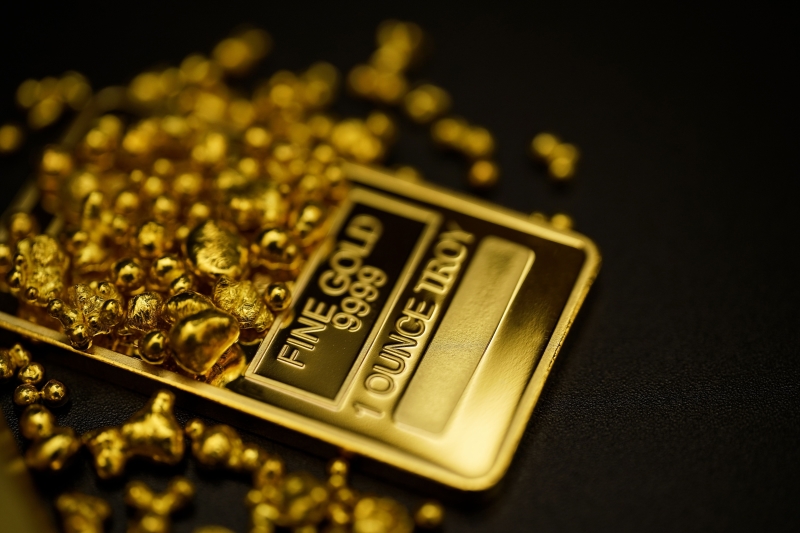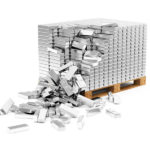Is It A Golden Era For Gold?

(March 13, 2024 - Stephen Jury, Managing Director JP Morgan)
Executive summary
- The price of gold is often driven by a complex interplay of factors, including the U.S. dollar exchange rate, real yields, supply/demand dynamics and sentiment. In recent years gold has exhibited a tendency to react to real yields in an asymmetric manner, supported by strong central bank purchases.
- We are constructive on gold given peaking real yields, elevated geopolitical uncertainties, robust central bank demand, and strong retail jewelry demand.
- For long term investors, gold merits a position in a diversified portfolio, potentially serving as short-term protection against risk events, a reliable longer-term store of value, and most importantly as a portfolio risk diversifier.
Gold has been a sought-after commodity for centuries, and a popular component in investment portfolios in modern times. The metal has historically delivered attractive long-term returns, appreciating ~8% on an annual basis over the past 20 years. That said, its price has exhibited significant volatility – with prices tumbling around 40% from 2011 to 2015, before it fully recovered in 2020. At the time of writing, the metal is making new all-time highs, breaking $2,180/oz on Mar 11, 2024.
The price of gold is influenced by a complex interplay of macro factors as well as supply/demand dynamics. Understanding its unique characteristics and benefits is crucial for investors who look to establish portfolios that endure through cycles. This article aims to identify and analyze the key drivers of gold prices, how they evolved in recent years, and how an appropriately sized gold investment can add value to a portfolio from an asset allocation perspective.
What drives gold prices?
- The level of the U.S. dollar
Historically, it would be fair to say that the value of the U.S. dollar is often negatively correlated with gold prices, as the metal is priced in dollars. When the USD weakens, gold becomes relatively cheaper for holders of other currencies, leading to increased demand. And the opposite is often true, with gold weakening as the dollar strengthens. However, there can be extended periods when this relationship breaks down. In 2012-13, for example, gold lost -18% of its value when the USD was fairly stable – rising less than 1%.
Looking ahead, we think the dollar environment should be relatively supportive for gold prices. After a significant rally in 2022 and a flattish 2023, the dollar is currently trading 10-15% higher than its fair value, implied by interest rate differentials and its own long-term average. Over the medium term, we think the dollar will likely revert to mean, and its overvaluation should be ultimately unwound. This process could take some time, as the dollar could be supported over the near term by cyclical growth outperformance in the U.S. relative to other major economies. That said, further strength from current levels should be limited. We expect U.S. economic growth and interest rates to gradually “catch down” to the rest of the world as the labor market wage increases cool down and the Federal reserve begins cutting rates, likely starting in the 2H.
U.S. DOLLAR STILL SCREENS ~10% OVERVALUED AGAINST INTEREST RATE DIFFERENTIALS
- Change in real yields
Historically, gold prices have demonstrated periods of an inverse relationship with real yields (i.e. inflation adjusted interest rates). As gold itself does not generate interest income, real yields can be seen as the opportunity cost of holding it. When real yields go down, gold becomes more attractive relative to interest bearing assets such as cash and fixed income securities. This inverse relationship explains a large part of the price increase in gold since the 1990s, as real yields progressed lower, down a path of structural decline. Large gold rallies such as those from 2008-2012 and 2019-2021 can also be attributed to real yields falling into negative territory, as global quantitative easing and Zero interest rate policies severely depressed yields.
However, over the past two years there has been a notable divergence between movements of gold prices and real interest rates. In early 2022 the Federal Reserve embarked on an aggressive tightening cycle at an unprecedented pace, under the backdrop of stubbornly elevated inflation and exacerbated global supply disruptions following the outbreak of the Russia-Ukraine war. Real yields rose aggressively from deeply negative territory to the highest levels seen since the Global Financial Crisis of 2008. 10-year U.S. real yields rose by a historic 250bps over the course of 2022, followed by another 20bps rise in 2023. In this environment gold prices remained very resilient. Prices were mostly unchanged in 2022, although with significant volatility, and in 2023 posted a +13% return, ending the year at a record high of $2,068/oz.
Has the correlation permanently broken? We believe it has temporarily shifted, and will likely reestablish itself at some point. We find that for now, gold still reacts to the movements in real yields, only in an asymmetric manner – it declines less when rates go up and rises more when rates move down. Why? The answer to that is largely related to a recent shift in supply and demand dynamics.
- Supply and demand dynamics
All commodities, at their core, are driven by supply and demand. The price of gold is affected by other drivers, as discussed above, but supply and demand is a key factor. Global mining of gold has been fairly stable for many years, and so the demand profile is particularly important and unique. This sets it apart from other commodities. There are several key sources of demand for gold, which can be categorized into three groups: industrial, investment and reserve management.
Industrial demand
- Jewelry fabrication. Jewelry demand accounts for around 50% of total annual gold consumption. As a beauty, permanence and status symbol, gold is highly coveted with demand particularly strong in Asia, especially from India and China.
- Technology. Around 10% of gold demand comes from industrial and technology uses, in industries including electronics, dentistry, aerospace and others.
Investment and Reserve Management
While investment and reserve management demand accounts for a smaller portion of total gold consumption, they can periodically be a more significant driver of gold prices. The impact of reserve managers or Central Banks has been more evident in recent years.
- Central banks
Central banks have been significant buyers of gold for decades. In the 19th Century most countries fixed the value of their currencies to gold, and this became known as the Gold Standard. Central banks were required to hold sufficient gold reserves to back their currencies and allow convertibility of currency into gold. This system was highly disciplined, but proved to be unworkable during times of crisis. Eventually governments found the need to expand monetary supply beyond the restrictions of the gold standard, and the system was abandoned after the Second World War to be replaced with the Bretton Woods System. This system fixed the dollar to gold at a set price and fixed international currencies to the dollar. Unsurprisingly this too proved to be unworkable, and as the United States began to run large deficits, strains began to emerge. Eventually the U.S. fully abandoned the link to gold in 1971, leading to the collapse of Bretton Woods. This allowed the price of gold to float freely on international markets. Although the need to hold gold as a reserve asset was now removed, the scarcity of gold inherently made it appealing to Central Banks as a store of value. This role has waxed and waned over the years, but as can be seen in the chart below – over the past 20 years, central banks worldwide now keep around 20% of their Foreign Exchange reserves in gold.
After a long hiatus, central bank purchases have risen notably in recent years. According to statistics compiled by the World Gold Council, net purchases by central banks around the world reached a record 1,082 tonnes in 2022, more than doubling the average annual purchase over the previous 10 years. This strong purchase momentum continued in 2023, maintaining a breakneck pace of 1,037 tonnes. This is now acknowledged to be a main driver of gold price resilience during the recent rise in real yields.
There are various reasons for Central Bank increases in the accumulation of gold. However, it has become apparent that in some cases, nations that are not allied with the United States have begun to look to reduce their reserve mix away from dollars, as they perceive the risks of keeping these reserves vulnerable to sanctions. Other governments aim to add some protection against higher and more volatile inflation worldwide, as the developed world exits the era of ultra-low inflation post-GFC. The scarcity of gold sometimes allows it to play a role as an inflation hedge, although this is often transitory.
- Retail and institutional investors
Many investors hold positions in gold as part of an investment portfolio. These investments can be made via exchange-traded funds (ETFs), futures markets, options or structured notes. Many investors prefer to hold the physical metal – and invest in bars, coins and claims linked to individually-numbered bars.
Holdings of gold ETFs have become more popular with retail investors since their inception in 2004 and hit a record in 2020 when the Covid pandemic caused worldwide lockdowns. Since then, holdings have been on a gradual decline, and now are back to pre-pandemic levels. Retail ETF flows in gold are often seen to be driven by fears of inflation, conflict or crisis, and the relative level of interest rates. These investors tend to be short term, but can be effective drivers of price.
Institutional investors are more long term and often hold the metal physically. Pension funds and Foundations, in particular, tend to hold the metal for decades.
Hedge Funds and Commodity Trading Advisers are more speculative in their approach, but can have prolonged impacts to price movements.
Our outlook on gold
We have a constructive outlook on gold over the next 12 months. We currently expect that the Federal Reserve will begin to cut interest rates in the United States – likely beginning in June, subject to revision. In our opinion this should set the stage for gold appreciation. A persistent theme of geopolitical tension should continue to drive Central Bank reserve diversification. In addition, 2024 will see over 60 countries – representing around half of the world’s population – heading to the polls for national elections. Tragically, two regional conflicts are still ongoing, and these may have an impact on global supply chains.
We look for more Central Banks to add to their buying momentum this year and assume these buyers may be less sensitive to prices. We look for retail ETF investors to come back to the market and begin accumulating gold once again as yields fall. Gold investment is not currently a crowded position. Investors have been lured by high cash interest rates – and we are particularly interested in this development. Under-owned and under-appreciated investments are often ripe for appreciation. Our current outlook for year-end 2024 is $2,250-2,350.
Gold in a portfolio
The best possible reason to own gold in our view is as a diversifier in a portfolio. This was perfectly illustrated in 2022 as global equity markets lost -19.46%, global bonds lost -16% and Gold rose 3%. The diversification benefits are amplified when viewed through the lens of modern portfolio theory, which holds that diversifying across lowly-correlated assets can improve overall risk-adjusted returns. Historically, gold has exhibited a low, or sometimes negative correlation to traditional asset classes, such as equities and bonds. In our view, having gold as a part of your asset allocation makes sense as a portfolio ballast that helps to enhance the risk-return profile.






